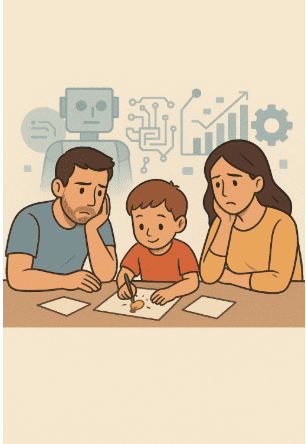Raising a child in today’s world of AI, automation, and algorithms isn’t easy. That’s why skills like lateral thinking are just as essential as critical thinking and creativity. These worries become more significant when your child is between the ages 3-7. This is the time when the prefrontal cortex (the brain’s control center for problem-solving) is highly flexible, making it the perfect window to develop lateral thinking.
The World Economic Forum’s 2025 Future of Jobs Report highlights analytical thinking as the top foundational skill, with creative thinking also among the highest-rated. This shows that tomorrow’s workforce will need to balance logic with imagination.
But here’s where lateral thinking becomes essential for your child as it acts as a bridge between analytical and creative thoughts. This raises an important question: what is lateral thinking and why is it considered so critical for children?

What is Lateral Thinking?
Lateral thinking is a way of solving problems by stepping outside traditional patterns of thought. Instead of searching for just one “right” answer, it encourages multiple possibilities and novel connections.
Research suggests that 98% of children score at a “genius level” in lateral thinking at age 5. By adulthood, that number falls to just 2%. This shows that while the ability comes naturally in early childhood, it needs to be nurtured deliberately if we want children to retain and strengthen it as they grow.
Intellectual Perspective of Lateral Thinking
In 1967, Dr. Edward de Bono introduced the term “lateral thinking” to describe a type of problem-solving that refuses to follow a straight line. Instead of asking, What’s the correct answer? It asks, What other answers might exist?
More than fifty years later, this way of thinking is no longer optional. It has become essential. In other words, the window in which children can develop this ability is both early and brief.
Yet here’s the paradox: most early learning centres still reward convergent thinking, which is finding the one “right” answer. The result? We risk raising children who are excellent at test-taking, but unprepared for a world that rewards those who can reframe, adapt, and innovate.
How Lateral Thinking Shapes Lifelong Problem-Solvers
Lateral Thinking is not just a milestone but a lifelong skill that helps children turn setbacks into opportunities. In today’s world, losing this ability can be career-limiting, especially when the future depends on adaptability and problem-solving beyond what machines can replicate.
With the right guidance through i-Maths, children can strengthen and accelerate lateral thinking, turning a fragile tendency into a durable, future-ready strength. In fact, the program is built on innovative educational practices for kids that make learning playful, engaging, and deeply impactful.
Watch a four-year-old play with a block tower, even when it falls, instead of rebuilding it in the same way, they flip the block sideways, balance them on a toy car, and declare it a “rocket ship.” To them, it is not a failure, rather it is an opportunity to reconstruct something more interesting. This is lateral thinking in its purest form: the ability to approach problems from unexpected angles.
The Breakthrough in Lateral Thinking
i-Maths offers a breakthrough for parents by offering a step-by-step module that does more than teach arithmetic. It helps children strengthen lateral thinking—the ability to see possibilities beyond the obvious—while also building critical thinking, which sharpens their capacity to evaluate, question, and make sound decisions.
Lessons are built around purposeful play, exploration, storytelling, and pattern recognition. These activities are then reinforced through simple presentations and problem-solving opportunities, creating guided moments where children learn to look at problems in new, creative ways.
Together, lateral and critical thinking form the foundation for future adaptability. If you’d like to dive deeper into how critical thinking can be developed even at an early age, check out this blog on critical thinking for preschoolers
How i-Maths Trilateral Method Helps With Lateral Learning
Learning comes alive when children can touch, see, and symbolize ideas.
The i-Maths Trilateral Method builds on this natural process, moving through three powerful stages: Concrete → Semi-Abstract → Abstract.
- Concrete – Kids start with hands-on exploration using real objects and manipulatives, building a strong, tactile foundation.
- Semi-Abstract – Next, they transition to semi-abstract tools such as charts and diagrams, where ideas take shape visually and mathematical concepts are enhanced.
- Abstract – Finally, they progress to the abstract stage, utilizing symbols, numbers, and activity books. They learn to apply and evaluate the concepts taught to them.
Importantly, this progression is framed within a learning paradigm where the environment is a third teacher and the educators just act as facilitators. i-Maths focuses on nurturing the curiosity, emotional resilience, and cognitive flexibility that children need to apply lateral approaches beyond the classroom.
In short, i-Maths doesn’t merely offer math activities for preschoolers; its multi-modal, play-based modules turn lateral thinking into a repeatable, transferable competency parents can see reflected in how their children solve real problems.
However, learning among kids is not limited to a particular class or a day. The easiest way to nurture curiosity and resilience is through everyday classes at home. So how can you, as a parent, bring this method into daily life?

Everyday Cognitive Habits for Parents
Here are some simple practical ways to replicate the Trilateral Method and make learning both natural and fun for your kids.

- Replicate the Trilateral Method at Home → Start with objects (concrete), move to drawings or charts (semi-abstract), then let kids explain rules or solve problems (abstract).
- Keep Sessions Short & Regular → Do focused 5–15 minute activities daily or every other day to build strong cognitive habits without tiring children.
- Encourage Exploration & Experimentation → Ask “What if we tried it this way?” to spark curiosity and out-of-the-box thinking.
- Honor Unique Expressions → Let children share solutions through drawing, storytelling, movement, or models—multiple modes strengthen abstract thinking.
- Connect Home & Class Language → Use i-Maths terms at home to link classroom learning with daily application for consistent lateral thinking.
Cultivating Minds that Reframe Challenges
In an era defined by automation, the highest-value human skill is the capacity to reframe problems and invent alternatives. Through a sequenced teaching method, like the Trilateral Method, purposeful play, and pattern recognition, kids develop lateral thinking habits that stick with them for the future.
For parents committed to raising resilient, inventive learners, integrating a few short, structured exercises at home is the simplest, most evidence-based way to protect and extend that advantage.
Ready to start your child’s journey into lateral thinking with i-Maths? Find an i-Maths center near you to enroll your kids now. For any queries, please fill the inquiry form and our team will get in touch with you.

